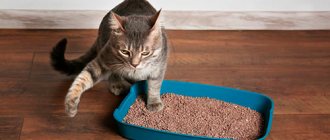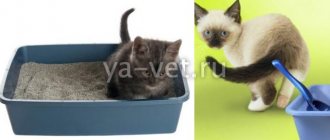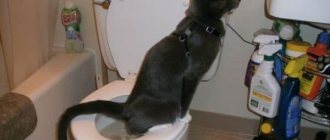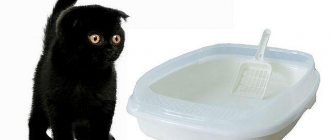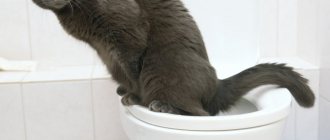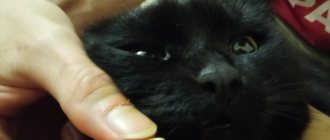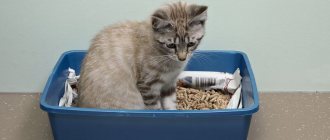There are a lot of people in the world who feel sorry for and warm animals, including homeless and defenseless ones. It happens that kittens are simply found, but they no longer have a mother cat. Then the care of the foundlings falls on the shoulders of those who want to help.
How to get a kitten to go to the toilet? In the first three weeks of life, kittens cannot take care of themselves. Then the act of defecation and urination is carried out only with active stimulation of the corresponding zones. Typically, the mother cat carefully licks the kittens under the tail, thereby causing emptying of the bladder and rectum. It is somewhat more difficult for a person to organize the process, especially if he has no experience in caring for kittens.
Recommendations
How to get a kitten to go to the toilet? After feeding, carefully and at the same time firmly fix the pet so that it cannot slip out. The fingers of the hand should be located simultaneously under the chest and stomach, so that the tail is towards the caregiver. You need to put a damp, warm napkin on your other hand, preferably white, but you can also use light colors, because it’s easier to tell on a light fabric whether the kitten went to the toilet or not.
Next, you need to stimulate the baby to urinate. Do not apply strong pressure and wipe the area from the lower abdomen to the anus. If the kitten went to the toilet (did not defecate - wiping continues), then you need to move to the anal area, doing a specific massage. Usually the effect occurs within a minute. But it happens that animals cannot go even after several feedings. Then you need to show him to a veterinarian.
After the job is done, you must first wipe the contaminated areas of the skin with a clean edge of the napkin (urine and feces are irritating, and dermatitis or a genitourinary tract infection may develop at the site of their appearance, since there is no strong immunity yet formed). It is also necessary to dry wet areas. This procedure is done for each kitten.
If there are several children, separate napkins are allocated for each of them (these can be pieces of bandage, gauze, cotton pads, which are thrown away after use). The whole procedure must take place in a warm room without drafts, otherwise the baby will become hypothermic and die.
Instructions for toilet training a cat
In order for the event of retraining a cat from a tray to a toilet to be successful, you must follow strict instructions. The sequence of steps is extremely important.
Training a cat to use the toilet proceeds sequentially
If the tray was not previously in the toilet, then the pet must first be introduced to the earthenware object and accustomed to the noise of the flush cistern. To do this, simply keep the door to the toilet room constantly open, and constant curiosity will lead the cat there itself.
When the pet stops showing signs of anxiety (if any), you can begin to take more decisive action.
Moving the tray to the toilet
This step is only relevant if the tray is located in another room, for example, in the bathroom. The cat potty should be moved to the toilet room and placed next to the toilet. It is recommended to do this slowly, moving the object 2–3 cm every day. Otherwise, the animal may get confused and begin to shit on the floor in the place where the tray was previously located. After the desired is achieved and the cat begins to relieve its needs in a new place, you can proceed to the next step.
You should gradually, a few centimeters a day, move the tray near the toilet
At the end of this stage, the tray should be in close proximity to the toilet, and the pet should defecate in it regularly.
The cat should do its business regularly in the tray in its new place
Raising the tray to the height of the toilet
The next step is to raise the tray to the level of the toilet seat. The cat must get used to the fact that its litter box is now high up and that it will have to jump up there. But this cannot be done abruptly, since the animal simply will not understand what is expected of it.
For 10–11 days, old magazines, newspapers, cardboard boxes and other things are placed under the tray, gradually raising it 1–2 cm at a time. If your pet refuses to climb high, then you need to stop for a few weeks and then start all over again.
It is extremely important that the structure does not wobble and is stable
You need to give the cat a few days to get used to jumping into the tray at a height
Moving the tray onto the toilet seat
For a couple of days, the litter box is left at the maximum height, allowing the cat to make sure that everything is stable and secure. Then the tray is moved onto the toilet by about ¼ part. Nothing should be loose, otherwise the pet will get scared and won’t jump in there anymore. Moving the pot little by little, after 3-4 days it is completely placed on the toilet. At the same time, the stack of magazines is gradually dismantled. At this stage, you can stop for a few days so that the animal develops a habit of the new place. If there was filler in the tray all this time, then the amount is reduced every day and then they stop pouring it altogether.
The cat potty needs to be firmly secured to the toilet
Tray refusal
This moment is the most important in the learning process. One day the tray is simply removed. Moreover, it must be removed so far away that the pet cannot find it by smell. When the cat comes to the toilet, at first he will fuss, not understanding what to do. But usually he thinks quickly enough and sits down on the edge of the toilet.
Sometimes it is recommended to pour a little filler into a small jar and attach it to a stick across the toilet using tape. Then the animal will be guided by the familiar smell, settle down and do its toilet chores on this box, sitting on the edge.
At the last stage of training, the cat must understand for himself what is required of him.
An alternative option is to move the toilet seat to the tray, and then put it back in place, but without the cat “potty.”
Cases of constipation in kittens per month of life
The causes of constipation are varied, but most often occur due to improper feeding, since the stomach does not yet accept too solid food (it is accustomed to breast milk or formula), the presence of infestation or hair in the stomach (long-haired cats suffer more often).
It is easy to detect: the baby does not go to the toilet for more than two days, the tummy begins to increase in size, the animal is worried and meows pitifully, the kitten can squat into a defecation position, but nothing comes out (the discharge can be the size of a bean seed).
Ways to help a kitten get things done
How to help a kitten go to the toilet? You can use enemas, the most effective are Microlax for children from zero years of age (after insertion, the anus must be closed with the tail, otherwise the microenemas will be of no use, and wait a little). In addition to the enema, massage the tummy in a clockwise circular motion. If feces appear from the anus, but cannot come out on their own, you need to begin to quietly and very carefully push it out. The kitten needs to be shown to a veterinarian not only if he was unable to go, but also for preventive purposes.
Outdoor toilet
How to train a kitten to go to the toilet in a private house? There are two methods to teach your baby to go to the toilet outside using a tray. The first is the gradual development of a habit. The second is the most common, but you need to monitor the animal’s reaction. If the baby looks for a dark corner after feeding, he tries to show that he wants to go to the toilet, in which case he needs to be taken outside. The actions must be repeated so that he can get used to doing his business near the house.
How to make a kitten go to the toilet if he is hiding? Close the doors before feeding, then he will be in sight. You can walk the cat after each feeding and wait for the result. This will have a good effect on digestion. Within a few days, you will develop the reflex to ask to go outside.
Urgent medical care
First aid in a veterinary clinic involves inserting a catheter. Only a professional should insert a catheter, after first flushing the bladder with antiseptics. This operation is painful, so it is performed under general anesthesia. After catheterization, the veterinarian performs a series of tests to find the cause of urinary retention.
Important: you should not insert a catheter often - after this procedure, swelling of the urinary tract occurs. If the doctor sewed in a catheter for several days, you need to keep the cat in a special collar during this time so that it does not injure itself and does not remove the catheter.
Toilet in the apartment
How to train a kitten to use the toilet in an apartment? Not all owners have the opportunity to take their pet outside after each feeding, especially since in the courtyard of a multi-story building there are many hidden dangers, ranging from physical injuries to infectious and invasive diseases. Therefore, it is advisable to accustom the kitten to the toilet in the apartment. To develop a strong habit, you need to take your baby to the place where the tray will be or is already located. When choosing a place for a cat's litter box, you need to take into account several nuances: cats do not like to be looked at during such a delicate task, the tray should be easy to get from this place.
What to fill with
It is naive to believe that your kitten will go to an empty tray or with only one piece of paper. Yes, this happens, and you’ve even seen it somewhere at a party, but by the time you teach him, an eternity will pass and it’s not a fact that he won’t be offended by you and start misbehaving out of spite. In addition, imagine an empty tray and a small amount of filler, the cat will come out all wet with urine, begin to shake its paws, splashing traces for many meters, and then climb into your bed. Don’t be greedy, buy a special litter or tear up a small newspaper, because it’s a cat’s instinct to bury feces deeply and thoroughly. It will be great if you do not disdain and take from the house of the previous owners a piece of material that smells like a mother cat (put it in the place where the pet will sleep) and a little used litter (preferably it also smells like a mother).
If the kitten has “watered” somewhere, great! We take the paper, blot it and drag it into a new tray. At the scene of the “crime” he can be scolded, hissed, for example, as a cat does, and taken to the toilet. Kittens have short memories, and the smell in the litter box will make him think he's been there before. The areas need to be washed thoroughly and a drop of citrus essential oil should be applied: the cat will be repelled and there will be a pleasant aroma in the house.
How do you know if your baby wants to relieve himself? Nothing could be simpler. Usually kittens begin to behave very anxiously, running circles around the rooms, sometimes even meowing. Learn to observe your pet. When you notice suspicious behavior, grab it and take it to the tray. And then wait, wait and wait again.
Once you have gained a little experience in recognizing cat behavior, you will be able to quickly stop attempts to go the wrong way. All you need is a simple spray bottle for indoor plants or a children's water pistol. Cruel? Not a bit! In fact, you can block your pet from running under the sofa with just one jet, and the stress that the cat experiences at the sight of water will help develop a strong reflex that shitting under the sofa is a bad omen - he is taking revenge.
In addition, very often a kitten's reluctance to go to the litter box may be due to his dislike of what you fill it with or the fact that you do not change the litter very often. Think about it. Try changing the filler more often; if everything remains at the same level, try different fillers. Not all cats like sawdust, since the essential oils of valuable tree species block their sense of smell.
A store-bought one, created specifically for cats, is an ideal option for an apartment because it absorbs moisture and odors, forming hard lumps that simply need to be removed from the tray from time to time and replaced with a new one.
It is important to monitor your baby to see if he eats the filler. To prevent this from happening, you can change the filler, but each time scatter the remains of the old one over it. The baby is unlikely to develop a burning interest in playing, much less eating something that smells like feces, because cats are very clean and squeamish by nature
The baby is unlikely to develop a burning interest in playing, much less eating something that smells like feces, because cats are very clean and squeamish by nature.
Getting a kitten is very simple, you just need a desire on your part to provide it with everything it needs and, of course, limitless affection. Only a happy kitten will perceive you as its “parent” who needs to be loved and obeyed unquestioningly.
Kitten training
How to get a kitten to go to the toilet if the previous owners did not teach him to go to the litter box? The main thing is not to get upset. During the day, you should watch your pet and take it to the place where the tray should be located. If the pet made a puddle or something else: for example, a person went into another room for literally half a minute or absent-mindedly missed the moment - then it is imperative to immediately clean up after the baby and clean the area with a strong-smelling detergent (if this is not done, the wrong habit may form) . Cats use their scent to navigate where to go to the toilet, and the kitten will return to this place again and again, rather than go to the litter box.
Diet for difficulty urinating
It doesn't matter what diagnosis the cat was given. If she has difficulty going to the toilet, this is a reason to reconsider her diet.
It is necessary to exclude cheap “economy” brands of food from her diet. They often irritate the mucous membranes, kidneys and urinary tract, causing additional pain in the cat’s body.
These foods contain a lot of salt, preservatives and dyes. The meat content there will be in last place, if it was used at all in the production of feed. It is recommended to switch the animal to expensive food of special brands designed specifically for animals with urological diseases.
It is strictly forbidden to give your cat:
- pork;
- salt;
- milk;
- raw meat;
- raw fish.
Some foods, such as pork or milk, will make the urine thicker, making it more difficult for you to pass out. Protein foods will overload the kidneys, and raw fish will create the likelihood of kidney stones.
The diet must be agreed with your doctor
Selecting a location
How to train a kitten to use a litter tray? If you are just planning to take a baby, then you need to immediately approach the responsible task correctly. The first purchase for a kitten, of course, is a tray, which it is advisable to choose correctly.
Let's look at some types:
- The cheapest option is a plastic tray with low sides. It washes well and takes up little space, but a significant drawback is that it is used together with filler granules, which the kitten can scatter or eat (you need to think about eating in advance).
- Tray with mesh. Can be used without filler. It has high sides. Cats like these because they look like boxes.
- Tray in the form of a house (closed type). The advantage of such a device is its aesthetics, the disadvantage is the high cost of the device.
- Self-cleaning tray. This option has a number of positive qualities: the cleanliness of the tray does not require the owner’s attention; no odor; Four pets can go into this tray; presence of a motion sensor; safety of capsules. The negative aspects are: connection to water supply and electricity, noisy flushing, which can frighten the animal.
What should I do to prevent bloating from appearing?
Simple rules to reduce the risk of flatulence:
- Eating should be slow, with thorough chewing of food, without distraction by extraneous actions.
- Avoid quick snacks on the go, smoking, and drinking alcohol.
- Limit the consumption of foods that increase gas formation.
- Avoid sugary carbonated drinks (there is nothing healthy in them).
- Drink enough clean water per day.
- Follow a proper diet (fried, fatty foods should not predominate)3.
Before a big feast or when overeating, it is better to take care of preventing bloating* in advance. To do this, you can take Creon® 10000 capsule with food or immediately after it. The active substances contained in the drug help natural digestion, reducing the risk of discomfort and heaviness after eating.
How to help a kitten?
How to get a kitten to go to the toilet? If the kitten is already familiar with the place where he needs to go to the toilet, but is not yet used to it, you need to wait until the baby fusses or starts digging. Then it is necessary to urgently carry it into the tray and not release it until the desired effect is achieved. The animal will monitor the reaction of the owner or mistress. You can praise him and pet him. There is no need to remove the contents of the tray right away: the baby will get used to it and remember the place faster. The main thing is not to use cruelty as punishment (deprive the kitten of water or food, leave it alone in the room, beat or push the kitten).
You need patience and perseverance - then the kitten will be everyone’s favorite, devoted to you for the rest of its life.
